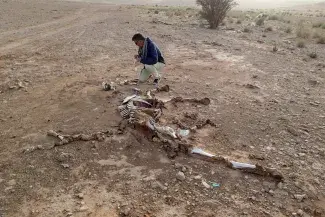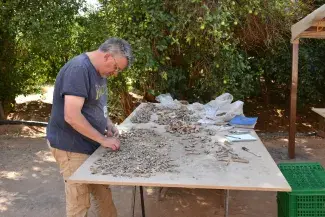
Researcher profile : Hervé Monchot
This week, we invite you to discover the work of Hervé Monchot, zooarchaeologist and director of the « Archaeozoological for AlUla Project » ( AZAP) : profile.
Hervé Monchot, zooarchaeologist and PhD in Quaternary Geology, led the AZAP project (Archaeozoology for AlUla), for two years, as part of the Jaussen & Savignac programme. This project, funded by the French Agency for the Development of AlUla (Afalula) on behalf of the Royal Commission for AlUla (RCU), is a research programme dedicated to the archaeozoology of the AlUla region, in Saudi Arabia.
Jaussen & Savignac Programme – Hervé, why did you choose to specialize in zooarchaeology?
Hervé Monchot – At the beginning of my university studies, I actually wanted to become a paleoanthropologist. I was fascinated by paleontology, the evolution of species over time, and the incredible ability of life to adapt to changing environments. My academic journey began with a naturalist programme at the University of Reims Champagne-Ardenne, where I studied subjects like biology, botany, zoology, and geology. In the 1990s, geology also included courses on prehistory and, naturally, on human evolution.
In 1990, I joined the DEA programme (second year of a Master today) in Quaternary Geology at the Institut de Paléontologie Humaine in Paris. What fascinated me most about this field was understanding humanity’s place within its environment — exploring the ancient worlds in which humans could survive (or sometimes struggle to survive), and everything that contributed to their subsistence. I was also interested in how early hominids fit into ecosystems where, at that time, they were more often prey than predators.
Within this discipline, I gained a solid foundation in zooarchaeology, including training in comparative anatomy, as well as in prehistoric studies.
When it came time to choose a PhD topic, Professor Henry de Lumley suggested that I focus my research on the animal bones from the Tautavel site in the Pyrénées-Orientales, since the human fossils from that site had already been extensively studied. Analyzing faunal remains — bones, teeth, horns, and so on — makes it possible to better understand how human groups lived, particularly through their subsistence strategies and their relationships with the animal world. I accepted this project with great enthusiasm, as it marked the beginning of my professional journey.
P J & S – After this first step and initial direction, what path did your research take?
H. M. – In 1996, I passed my PhD viva in Quaternary Geology at the University of the Mediterranean in Marseille, in collaboration with the Department of Prehistory of the National Museum of Natural History (Institute of Human Paleontology). My doctoral research, under the supervision of Professor Henry de Lumley focused on small bovids from the famous prehistoric site of Tautavel in the Pyrénées-Orientales. It is worth remembering that at that time, researchers specializing in archaeozoology typically focused on a specific taxon, a particular period, or a defined geographical area.
After earning my PhD, I obtained several postdoctoral contracts funded by the European Union to work on Palaeolithic bone material in Italy and Spain. Then, in 1998, I was awarded a Fyssen Foundation fellowship to study unpublished bone material from the Lower Palaeolithic site of Holon in Israel, at the Hebrew University, in the Laboratory of Ecology, Systematics and Evolution. This study marked the beginning of my work in the Near East.
Subsequently, the same laboratory entrusted me with the study of the fauna from several sites that had not yet been analyzed or published at the time, such as Geula Cave (Mount Carmel, Israel). It was during this period that I became familiar with the faunal assemblages from the ancient sites of the Levant.
P J & S – Your experience is impressive and very international. How did your career lead you here?
H. M. – Through the publications and presentations I gave on the subject, I had the opportunity to meet colleagues from different countries. By chance, during these communications, I reconnected with researchers who would profoundly influence my professional path. I believe that life is often shaped by such meaningful encounters — by those who, through their trust, give you momentum and awaken an interest in areas you might never have considered studying initially. This is why I always encourage students to stay open-minded throughout their professional journey. My meeting with Guillaume Charloux in 2005 is a good example. At the time, he was excavating the forecourt of the Temple of Opet at Karnak (Egypt), and he invited me to study the remains of sheep and goats found on this legendary site. It was on this site that I took my first steps into the study of both ancient and more recent periods. It was an extraordinary experience for me, full of new challenges, as I had to develop new skills in areas that had not been part of my initial training.
Afterwards, I worked on various projects that took me to Djibouti, Iran, Armenia, and most notably, Canada.
P J & S – To Canada? You found yourself on the other side of the world for your research, didn’t you?
H. M. – In 2007, I applied for a call for proposals and was awarded a four-year contract in Montreal with the Avataq Cultural Institute, which entrusted me with numerous archaeozoological studies across the Inuit territory of Quebec (Nunavik). took part in three field missions in the Far North. It’s fascinating to see that these sites, which date back around 2,000 years — roughly to the beginning of our era — are entirely centered on the animal world, yet show no evidence of domestic species for survival. This way of life is very similar to what we can observe in our own regions… during prehistoric times. I learned a great deal about human subsistence strategies and the remarkable ability of people to adapt to harsh and unforgiving environments. The end of this very unique mission coincided with the creation of the French Laboratories of Excellence (LabEx). With the support of Guillaume Charloux, I joined for two years the Laboratory of Excellence "Religions and Societies in the Mediterranean World" (RESMED), based within the Mixed Research Unit “Orient et Méditerranée” (UMR 8167). This study project included four major sites: Khirbet es-Samra (Jordan), al-Kharj, ancient al-Yamâma, et Dumat al-Jandal (Saudi Arabia) as well as Saint Simeon Sanctuary (Syria). I left for excavations in the Arabian Peninsula the day after returning to France — and what a change it was: leaving the cold desert of the Arctic to face the harsh, hot deserts of the Arabian Peninsula!
P J & S – And is that when you started focusing your research on the Levant countries?
H. M. – At the same time, after long and exciting discussions, Jean-Baptiste Humbert, the renowned Dominican archaeologist I had previously met for the study of Samra, entrusted me with the study of all osteological collections from the excavations of the École Biblique et Archéologique de Jérusalem, including those from Gaza, Jerusalem, and Amman.
This research led me to spend many summers over almost ten years in Jordan and Palestine. Although the studies are nearly completed today, the publication of this work of such magnitude is not yet finished.
During one of these stays, in 2013, I met François Villeneuve, a professor of archaeology at the University of Paris 1 Panthéon-Sorbonne. We got along well, and François entrusted me with the study of the bone material from Dharih (Jordan). From that time onward, everything moved quickly: I was called to work on numerous sites and collaborated on many missions throughout the Middle East, but also in Central Asia, such as at Petra (Jordan), Qalhât (Oman), Failaka (Kuwait), Banbhore (Pakistan), not to mention Kabul in Afghanistan in 2017 and 2018.
P J & S – How did the AZAP project get started?
H. M. – During a mission at Yarmouk University in Jordan, where I was studying the bones from Dharih, I met Jérôme Rohmer, who had come to study some of the ceramics from the same site for François Villeneuve. Jérôme, who was in charge of the excavations at Thaj in Arabia, told me that he had a new project in northern Arabia and that he would consider me for the study of the bone remains. It was thus that, in 2020, after the Covid crisis, Jérôme entrusted me with the material from Dadan in AlUla.
Later, during a conference at AFALULA in Paris, I met Ingrid Périssé-Valéro, who, together with Jérôme Rohmer, spoke to me about the idea of a research project specifically dedicated to archaeozoology in AlUla. After more than a year of development, this idea led to the creation of AZAP, which I currently direct, and which is fully integrated into the Jaussen & Savignac training and research programme at the University of Paris 1 Panthéon-Sorbonne.
P J & S – As we finish our conversation, in your view, what insights can archaeozoological research offer to contemporary society?
H. M. – Human behaviors related to subsistence and the ways in which groups feed themselves are fundamental questions that have spanned the centuries. The relationship with animals and the issues surrounding it today, however, are quite new… As Brillat-Savarin (1755–1826) famously said, “Tell me what you eat, and I will tell you who you are.” In reality, in prehistoric societies, such questions were not considered: people had to eat to survive. From the Bronze Age and for 2,000 years in Arabia, diets remained largely the same: the basic meat-based diet consisted of sheep, goats, and camels, as well as fish for those living near the coast. It was only in the 1950s, with the implementation of large-scale agricultural policies, the electrification of roads and villages, and the development of international trade bringing goods from the other side of the world, that eating habits began to change.
Studying this aspect of diet touches on our identity and the everyday life that defines us: archaeozoology provides direct evidence of human daily life, food, and the ritual practices associated with it.
Fundamentally, I work on the study of life itself: whatever the animal bones, they speak to us about humans—their place in ecosystems, their habitats, their ways of living, their dietary practices, and even their evolution. And that, for me, is what makes this work so fascinating.
Hervé Monchot's research themes
His bibliography
